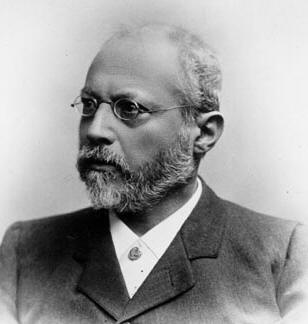Max Noether (1844-1921)
algebraic geometer
|
Max Noether was born in Mannheim to a family long engaged in a wholesale hardware business. At the age of fourteen, he was stricken by polio, but be completed the Gymnasium curriculum through home-study, and on his own, he began studying higher mathematics.
He entered the University of Heidelberg in 1865 and received the Ph.D. degree there three years later. After serving on the faculty at Heidelberg for several years, he joined the faculty at the University of Erlangen and was an ordinarius (i.e., full professor) there from 1888 to 1919.
In 1880 Max Noether married Ida Amalia Kaufmann. Their daughter Emmy Amalia Noether was born in 1882.
|

|
Max Noether is remembered as one of the founders of algebraic geometry. To some extent, Emmy Noether extended some of her father's work, and in this connection, Hermann Weyl wrote,
Noether's residual theorem was...fitted by Emmy into her general theory of ideals in arbitrary rings. This scientific kinship of father and daughter÷who became in a certain sense his successor in algebra, but stands beside him independent in her fundamental attitude and in her problems÷is something extremely beautiful and gratifying.
The father was÷such is the impression I gather from his papers and even more from the many obituary biographies he wrote for the Mathematische Annalen÷a very intelligent, warm-hearted man of many-sided interests and sterling education.
Noether's Fundamental Theorem was proved in
Max Noether, "†ber einen Satz aus der Theorie der algebraischen Functionen," Mathematische Annalen 6 (1873) 351-359.
The hypothesis of the theorem is that two algebraic curves f(x,y)=0 and g(x,y)=0 meet in a finite set S of points; the conclusion is that under certain conditions (now called the Noetherian conditions), there is an algebraic curve of the form
a(x,y)f(x,y)+b(x,y)g(x,y)=0,
where a and b are polynomials in x and y, which passes through all the points of S. A proof different from Noether's, and in English, is given in
Charlotte Angas Scott, "A Proof of Noether's Fundamental Theorem," Mathematische Annalen 52 (1899) 593-597.
Additional works on Max Noether, including lists of his publications, are given in
F. S. Macaulay, "Max Noether," Proceedings of the London Mathematical Society 21 (1920-23), 37-42.
M. Menghini, "Notes on the correspondence between Luigi Cremona and Max Noether," Historia Mathematica 13 (1986) 341-351.
A. W. von Brill, "Max Noether," Jahresberichte der Deutschen Mathematiker-vereinigung 32 (1923) 211-233.
Emmy Noether, Mentors & Colleagues
Emmy Noether
Clark Kimberling Home Page
